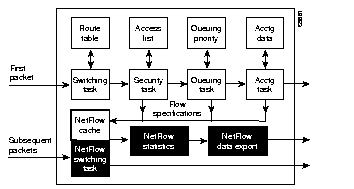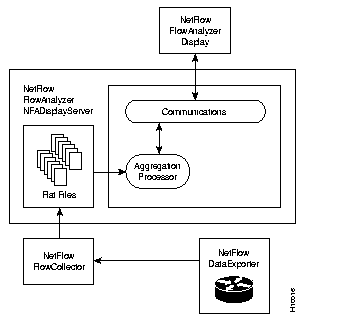|
|

This chapter describes the NetFlow FlowAnalyzer system and its components. This system is used to read, analyze, and display NetFlow switching data collected by the NetFlow FlowCollector application.
NetFlow switching is supported in the following Cisco IOS releases:
Release 11.x (or later) for the following routers:
Release 11.1(5) or later for the following routers:
Cisco IOS provides expanded security, quality of service, and enhanced traffic management capabilities within the NetFlow switching framework. Related network services are based on managing traffic flows between network layer address pairs visible to the NetFlow FlowCollector application.
NetFlow switching is a high-performance network-layer switching mechanism that captures as part of its switching function a rich set of traffic statistics, including per-user, per-protocol, per-port, and per-type of service statistics. These statistics can be used for a wide variety of purposes, such as network analysis and planning, accounting, and billing.
NetFlow switching provides network administrators with access to call detail recording information for their data networks. Exported NetFlow data can be used for a variety of purposes, including network management and planning, enterprise accounting and departmental chargebacks, ISP billing, and data warehousing/mining for marketing purposes. NetFlow also provides a highly efficient mechanism for processing security access lists without paying as much of a performance penalty as is incurred with other available switching methods.
Figure 1-1 shows a comparison between conventional network layer switching and NetFlow switching.

The NetFlow system reads, analyzes, and displays NetFlow switching data collected by the NetFlow FlowCollector application. The NetFlow system includes three main components:
Figure 1-2 shows the NetFlow system and its components.

The NetFlow FlowCollector application, the FlowCollector, provides fast, scalable, reliable, and economical data collection from multiple Cisco routers exporting NetFlow data records containing traffic statistics. Data is stored in aggregation schemes for later retrieval and analysis.
Some functions of the FlowCollector include
The NetFlow data records exported by the routers consist of expired traffic flows containing detailed traffic statistics. These traffic statistics contain information about network Layer 3 sources and destinations, down to the level of individual applications and protocols with end-to-end conversation. This information about the routers
The following items are included in the traffic statistics:
The FlowCollector collects detailed traffic statistics and summarizes the data (that is, aggregates the flows) by any of the following aggregation schemes:
These aggregation schemes are described in more detail in the chapter entitled "Using the NetFlow FlowAnalyzer Display."
You can apply filters to the aggregation schemes to customize traffic statistics by specifying one or more of the following fields:
Figure 1-3 shows an example of a typical network of routers with the FlowCollector running on the destination host. Each router is configured with the destination host's IP address and destination UDP port number. After you configure and start the FlowCollector application, the FlowCollector listens to the user-specified UDP ports for NetFlow export datagrams from the routers.

The NetFlow Data Exporter makes possible the bulk export of traffic statistics. A summary of traffic statistics for all expired traffic flows can be exported periodically through datagrams to specified destinations, including traffic probes, management applications, and other data sinks.
The NetFlow FlowAnalyzer application, the FlowAnalyzer, is a network management application that includes a server and a user interface. You can use the FlowAnalyzer to display data collected by the NetFlow FlowCollector application.
The FlowAnalyzer DisplayServer program receives requests for traffic statistics from the FlowAnalyzer user interface and provides data collected in flat files created by the FlowCollector. The data is displayed by the NetFlow FlowAnalyzer user interface.
The FlowAnalyzer user interface uses a browser to display the data collected by the FlowCollector in a variety of formats, including
Users can also specify time intervals and the number of entries to be displayed.
You should run the FlowCollector with the UTC (GMT) reference. To run the FlowCollector in this mode, you must edit the nf.resources file and type yes on the line that includes GMT_FLAG. For example
GMT_FLAG yes
If you do not run the FlowCollector with the UTC reference, you must specify a distinct DataSetPath option for each local time zone of your data collection. For more information about the FlowCollector, refer to the NetFlow FlowCollector Installation and User Guide.
You should specify router names in the decimal-byte format a.b.c.d (for example, 171.69.204.5) to ensure that the analysis module can locate the requested data for that router. The FlowCollector should use the dot-decimal format to avoid data from the same router being stored in more than one location in the database.
To run the FlowCollector in dot-decimal format, you must edit the nf.resources file and type yes on the line that includes DEV_DOTTEDADDRESS. For example
DEV_DOTTEDADDRESS yes
Data collection and analysis cannot be guaranteed when you are using aliases to name routers. If the FlowCollector cannot obtain the router's alias to identify the router, it uses the decimal-byte format DEV_DOTTEDADDRESS. A database will include a combination of router aliases and decimal-byte formatted router names unless all data collection is done with the DEV_DOTTEDADDRESS format set to yes.
|
|